Battle of the narratives on « The Isle of Secrets »
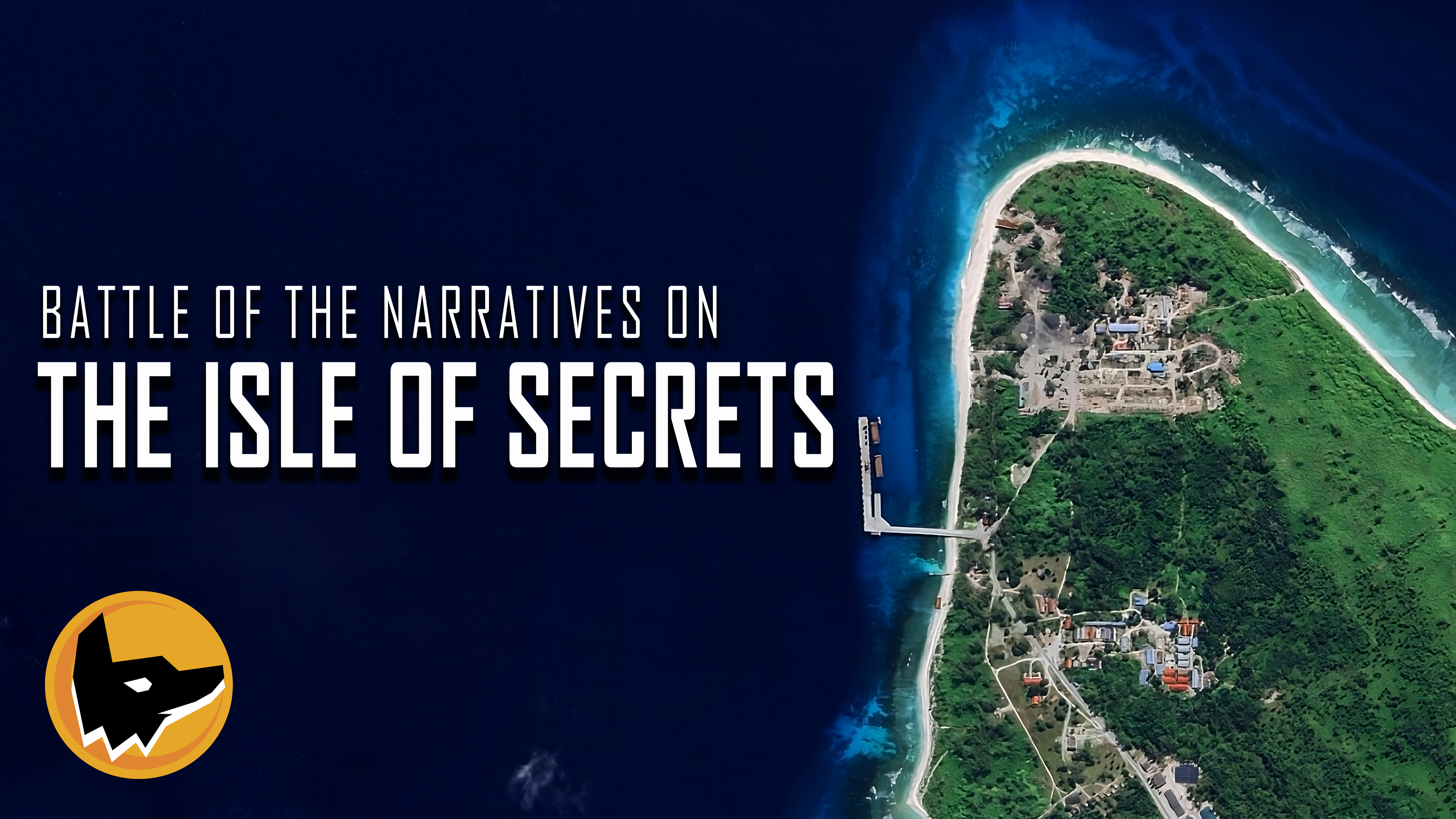
There are places that seem to be on the bangs of the “great march of the world”, places that seem to have no political or economic interest for anyone. Yet huge secrets lurk there. When one of them is finally exposed, the revelation itself often raises as many questions as the secret already did.
Such is the case of the Agaléga archipelago, two islets with a total surface area of 25 km2, lying on an ocean ridge south of the Seychelles, and belonging to the Republic of Mauritius. On the northern islet, mangroves give way to coconut plantations and the two main villages, “La Fourche” and “Les 25”. Most of the 300 Agaléens live here, under the relaxed authority of the Resident Manager of the Outer Island Development Company. In all these respects, Agalega is a minor territory, a minor power. Yet on August 3, 2021, the Qatari media outlet Al Jazeera (AJ) published a ten-page report on its website, the most visited in the Arab world[1], linked to a 16-minute video soberly entitled “The Island of Secrets”. Various groups with divergent and often unclear interests then engaged in a minor informational war over an Indian military base allegedly built, in the greatest secrecy, on the northern islet of Agalega.
One year on, as the scandal gradually turns into a crisis, this article looks at the actors who have contributed to the creation and reinforcement of the current dominant narrative, the way in which their interests converge, and the relevance of the affair to a reading of the dynamics at work in the Indian Ocean. Finally, we question the importance of information warfare in “sub-threshold” power struggles, and offer some answers as to its relative ineffectiveness in peripheral regions.
[1] AL JAZEERA « Agaléga, a secret base, and India’s claim to power » [online] posted on 03/08/2021 [accessed 20/11/2022]
August 2021: The investigation
The report published on August 3, 2021 and its video version are impressive. Using satellite images, official documents, international agreements and exclusive information, they detail an edifying chronology worthy of a novel. In February 2020, a ship, the Glocem, flying the Panamanian flag but owned by Mumbai-based Afcons Infrastructure, spent two weeks in the port of Visakhapatnam, Andhra Pradesh. The city, Qatari journalists reveal, is also home to the headquarters of the Indian Eastern Naval Command. It then sailed the 4,274 km to Agalega, unloaded its unidentified cargo and set sail again. In the months that followed, seven other ships (Panthera, Archagelos Michel, Asali, Pangeo, Norderney, Alam Sayang and Mana) belonging to Afcons infrastructure, followed Glocem’s example[2].
The Qatari news provider backs up its claim with a demonstration: the video shows a globe tracing the routes of the highlighted ships, and the written report includes satellite images of the archipelago where the reader can move the cursor to see for themselves the drastic changes that the northern islet of Agaléga is undergoing in the year 2020. Where a tiny landing stage once graced the Mauritian National Coast Guards office north of La Fourche, a huge, modern jetty reaching deep into the water seems to have risen out of the sand. A thick coconut grove is followed by a large area that Al Jazeera is content to show without naming, even in the video[3]. To the south of the new jetty, where a crane and “zig-zag” pontoons can be seen, which they claim will increase the jetty’s capacity, already stands what they call an “L-shaped jetty” without, again, making any further conjectures.
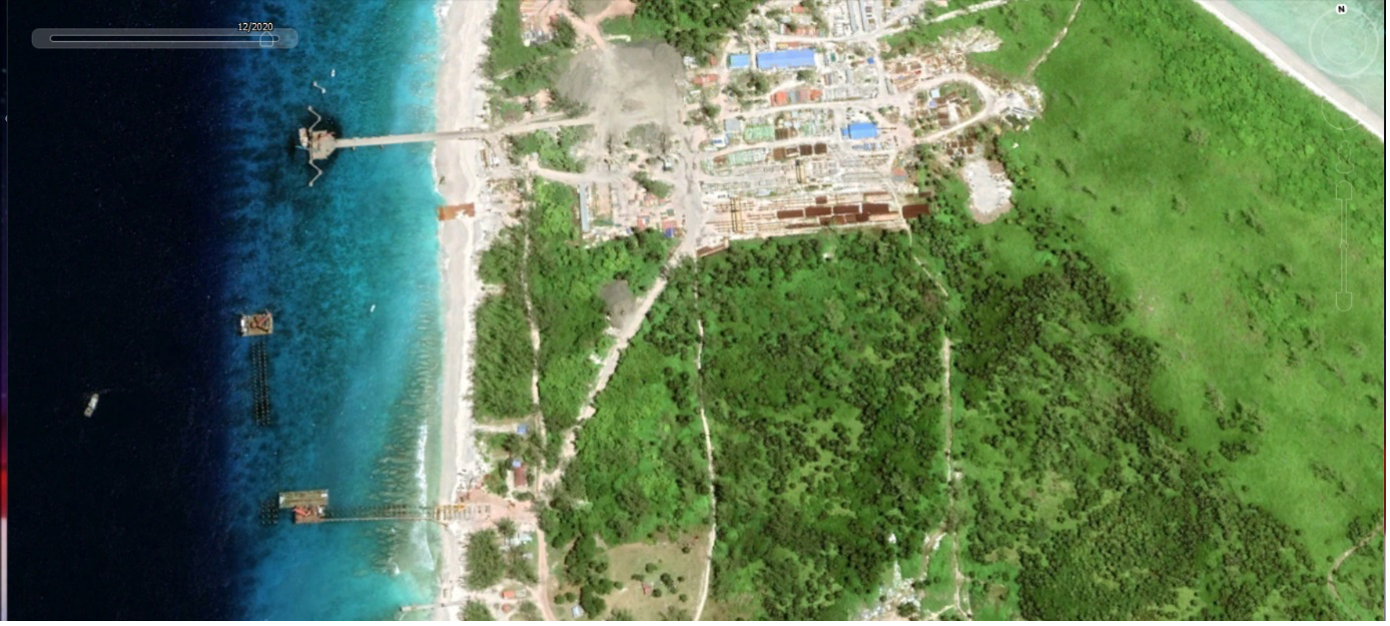
The investigative work continues: the Doha journalists dig into the archives and find a Memorandum of Understanding from 2015 (six years before the publication of the survey), concluded between Port-Louis and New Delhi. A discreet article mentions a “joint infrastructure development project” on Agaléga-Nord. A year later, the credits allocated to the said development made an equally discreet appearance in the Indian defense budget[4], and in 2018, Mauritian Prime Minister Pravind Jugnauth announced the start of work, before retracting the announcement and citing a misunderstanding. The Qatari media devotes a long paragraph (embellished with caricatures showing India as a snake charmer making a fighter-headed rattlesnake dance on Agaléga) to the taboo that hangs in the region over the construction of military bases by foreign powers. The trauma was born in the Chagos archipelago, on the Diego Garcia atoll, leased by the British to Washington to build their main base in the area, and of its expelled people still militating for the right to return home.
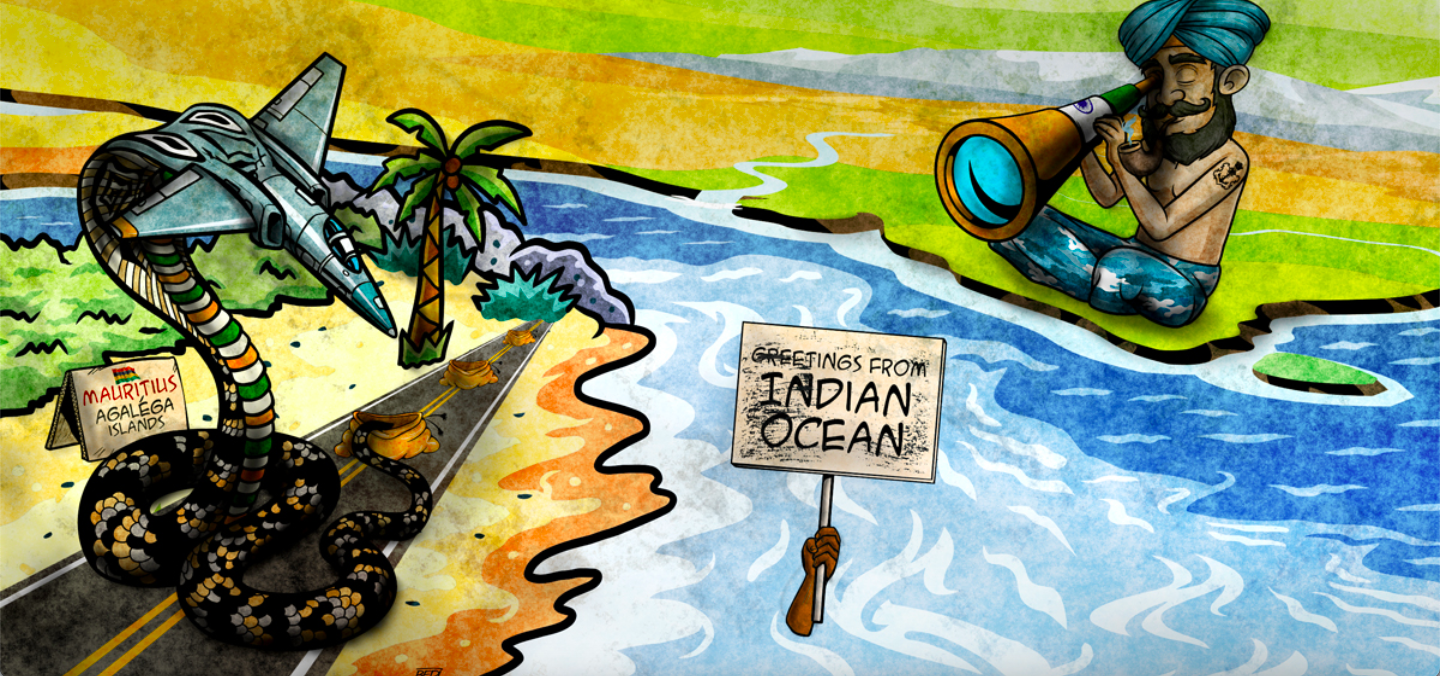
According to AJ, the project was then only postponed, and began to take shape from 2020, in a much more discreet manner.
The article and video then show that by the end of 2020, a new airfield, 3 km long and covering almost the entire length of the islet, will make the small, historic 200 m runway pale into insignificance. All jumbo jets, including A380s, can land there, but AJ insists on the Indian Navy’s Boeing P-8I Poseidon[5]. Next to the airfield, the report points to a “parking lot” which, it claims, could eventually accommodate “dozens of vehicles”[6].
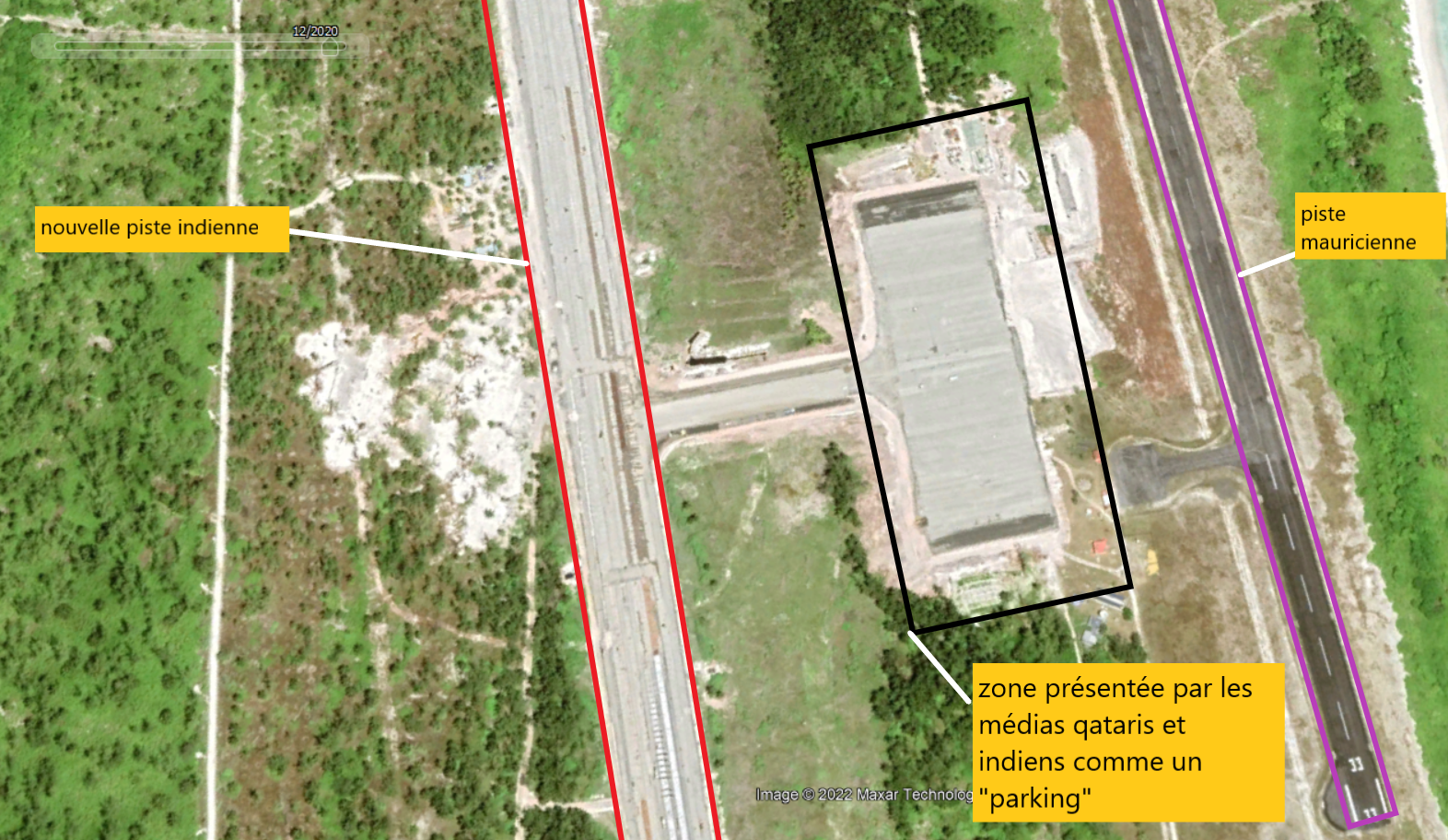
At that point, and without presenting any images other than new caricatures[7], AJ speaks of a veritable military complex built in secret by Afcons at The Forks, with “barracks, offices, sports facilities dedicated to military training”. Several guests, such as geopolitical experts Aaditya Dave and Samuel Bashfield, from different countries (the UK and Australia) and taking an analytical look at the impressive amount of data collected by AJ, lend credence to the thesis of a military base for the Indian navy. Indeed, they emphasize Agaléga’s alignment at the exit of the Mozambique Channel, between the French civilian radar station at Tromelin and the U.S.-British naval base at Diego Garcia (the two facilities being presented as equal in scale), in what AJ presents as a “continuous and consistent policy for the establishment of an Indian presence throughout the Indian Ocean”, citing the construction of “radar stations and naval bases in Sri Lanka, the Seychelles, Bangladesh and the Maldives”. The article concludes with a section entitled “Denials”, which lists those involved in the project and their refusal to answer Al Jazeera’s questions.
[2] AL JAZEERA « Agaléga, a secret base, and India’s claim to power » [online] posted on 08/03/2021 [accessed 11/20/2022]
[3] AL JAZEERA ENGLISH « The Island of Secrets | Al Jazeera Investigations” posted online on 08/03/2021 [accessed 11/25/2022]
[4] AL JAZEERA « Agaléga, a secret base, and India’s claim to power » [online] posted on 08/03/2021 [accessed 11/20/2022]
[5] KAUSHIK, Krishn « Explained : P8I, the Indian Navy’s frontline multi-mission aircraft » The Indian Express [online] updated 02/25/2022 [consulted 11/25/2022]
[6] AL JAZEERA « Agaléga, a secret base, and India’s claim to power » [online] posted on 08/03/2021 [accessed 11/20/2022]
[7] AL JAZEERA « Agaléga, a secret base, and India’s claim to power » [online] posted on 08/03/2021 [accessed 11/20/2022]
Media, actors in the crisis
The main media, which created the first version of the dominant narrative on Agalega, is therefore Al Jazeera (AJ). Owned by the Emir of Qatar, majority shareholder since its foundation in 1996, AJ initially broadcast news from a liberal, “modernist” perspective on Middle East current affairs, earning it a reputation as a free, avant-garde medium, before following the reorientations of its owner-state’s foreign policy and splitting up its lines of action. In its Western branches (such as “AJ+ Français”), it became the standard-bearer of progressive discourse[8] while firmly supporting, in its Arabic-speaking and Balkan branches, the ultra-conservative and fundamentalist visions that the Doha regime shares with the Muslim Brotherhood[9] [10], AJ is a highly effective propaganda organ whose editorial line is firmly controlled by Emir Al Thani and his clan.
In the months following the publication of “Island of Secrets”, the main Indian media, whether pro-government (such as the highly nationalist Hindustan Times) or not (such as the Internet medium Nutshell, which takes a rather didactic-sensationalist line), reprinted AJ’s investigation in its entirety, even inflating the more juicy aspects. Nutshell, for example, treats the future “L-shaped jetty”, the “airfield parking lot”, the military barracks and installations in the same way word for word, adding “firing range” and “space dedicated to military ceremonies”. It’s essential here to return to a semantic point that we’ll come back to later: while in French, a “jetée” simply means an overhang built on the sea over which one can walk, in English (the language of the Indian, Mauritian and AJ media), there is a clear distinction between pier and jetty, based on the open or closed nature of the structure, and its ability to protect the coast or not. To describe the structure as a jetty is therefore to say that India is building an artificial harbour on the islet, a very heavy undertaking (in terms of meaning).
The news spread fairly quickly in the Indian public arena, taken up by supporters of Hindu nationalism as welcome proof of India’s growing power, and by opponents of the government and anti-militarists as an odiously guarded secret project. The Modi government has made no official statement.
In Mauritius, and in Réunion media such as Réunion La Première, the Al Jazeera narrative is amplified[11] : P. Jugnauth, having presupposed the support of the population and privileging the superiority of pro-Indian sentiment in Mauritius (an island with a Hindu majority) over the trauma of the Chagossians, would have preferred, in the light of the reaction in 2018, to switch to a strategy of active concealment of the project. Soon enough, journalists on Reunion Island were looking for a balance and also broadcasting the government’s version, that of simple adjustments designed to improve the lives of the Agaleans. They had long been calling for better medical facilities and transport infrastructure to the mother island[12] [13], although with Indian investment, which would be in line with New Delhi’s policy of investing in Mauritian infrastructure, particularly in the construction of the metro[14]. The Mauritian media are quick to pick up on even the most minor incidents at Agaléga, especially when they involve the Indian workers on site. This was the case in May 2022, when “serious incidents” (a drunken brawl) in the workers’ camp sent several to hospital on the mother island[15].
[8] MATHOUX, Hadrien « “AJ+ Français“ : Quand la propagande du Qatar se cache derrière un féminisme progressif et LGBT » Marianne [online] posted on 04/25/2018 [consulted on 11/26/2022]
[9] KEPEL, Gilles « Macron à Dubaï, Doha et Djedda : Géopolitique d’un itinéraire » Le Grand Continent [online] posted online 10/12/2021 [consulted 26/11/2022]
[10] ELHADY, Emad « The Western Media Misguided Narrative about Al Jazeera » The Washington Institute [online] posted online on 03/22/2018 [consulted on 11/26/2022]
[11] KARGHOO, Christophe « Base militaire à Agaléga : entre doute, crainte et frayeur » 5 plus Dimanche [online] [accessed 11/27/2022]
[12] FLOCH, Fabrice « Maurice : l’Inde ne souhaite pas transformer Agaléga en base militaire » Réunion La 1ere [online] posted online on 05/19/2021 [consulted on 11/27/2022]
[13] FLOCH, Fabrice « Maurice : Agaléga ne servira pas de base militaire à l’Inde selon le gouvernement » Réunion la 1ere [online] posted online on 09/19/2022 [consulted on 11/27/2022]
[14] BEAU, Nicolas « L’Inde pilote le développement économique de L’île Maurice » MONDAFRIQUE [online] posted online on 10/14/2022 [consulted on 11/27/2022]
[15] ANONYME « Agaléga : graves incidents entre des travailleurs indiens » Le Mauricien [online] posted online on 05/17/2022 [consulted on 11/27/2022]
What collusion of interests is involved in creating and reinforcing the anti-Indian narrative?
In this way, the Al Jazeera narrative finds itself in a directly dominant position. The Indian government remains silent and does not participate in the creation of a counter-narrative. The Jugnauth government therefore finds itself alone, and its version is poorly relayed by a local media field that is not sympathetic to it (with the exception of the state media body, MBC, and the recent Mazavaroo media[16]),
The Reunionese media are not widely read in Mauritius, and only broadcast his statements in the interests of equal information. All the media covering the affair have no local correspondents and very little material on Agaléga. These media repeat word for word the statements made by “L’île aux secrets”, notably the glaring error of referring to Agaléga as a single island, or of directly describing the structure under construction as a “L-shaped jetty”, without satellite images being able in themselves to confirm this.
If the Mauritian opposition’s interests in denouncing the ruling group are clear, why would AJ, and therefore the Qatari state, invest so much in an investigation targeting a peripheral region on a scandal involving India and a minor African power? If the Mozambique Channel is a vital passage for much of the world’s trade[17], Qatar is above all dependent on the Suez Canal and has no a priori interest in disrupting the establishment of Indian control in the zone. Nevertheless, Qatar has drawn closer to Pakistan[18] since the Gulf crisis in 2017[19], and has since entered into a protracted diplomatic crisis with the Modi government[20] over the Islamophobic policies of the Hindu nationalists. Doha and Islamabad can therefore only worry about the formation of a “Hindu bloc” resulting from New Delhi’s very real military cooperation with Bangladesh, the Maldives, the Seychelles and Sri Lanka… For Qatar, revealing the situation at North-Agaléga with implacable proof would at least put a stop to the project and prevent India from planting a new flag in the Indian Ocean; at most, it would call into question the privileged relationship maintained by the occupants of Fort Rouge with those of Clarisse House.
[16] Interview of a Mauritian journalist with the author, December 2022.
[17] VALLÉE, Olivier « Le canal du Mozambique : un espace géocritique » Le Grand Continent [online] posted on 04/15/2021 [consulted on 11/29/2022]
[18] MÜLLER, Quentin « Qatar. Comment l’Indie et le Pakistan profitent de la crise » OrientXXI [online] published on 01/03/2018 [consulted on 29/11/2022]
[19] BARTHE, Benjamin « Crise entre Qatar et Arabie Saoudite : Riyad ne veut pas laisser ses vassaux s’émanciper » Le Monde [online] posted on 07/03/2017 [consulted on 11/29/2022]
[20] FARCIS, Sebastien « Crise diplomatique entre l’Inde et le Moyen-Orient » RFI [online] posted on 06/06/2022 [consulted on 11/29/2022]
The Mauritian political field in the informational battle
n Port-Louis, Xavier-Luc Duval, leader of the opposition and of a camp that can be described as “sovereignist”[21]increased his speeches in the Assembly, relayed by the very critical newspaper Le Mauritian. This newspaper goes beyond the Al Jazeera narrative by speaking of a “suffocating climate of terror in the Agaléga archipelago” after the police summoned 40 Agaléans who participated in a symbolic demonstration against “militarization” of the northern islet[22]. Le Mauricien links the situation to the “technicians affair” which had shaken the island a few months earlier[23], when the opposition press revealed that the Jugnauth government had facilitated eavesdropping by Indian intelligence services. Chinese communications on the internet cable networks which cover the Mascarenes area. The Agalean government is presented as sold to India, ready to abandon entire sections of its territory (and its population) to a foreign power. Faced with the “development” counter-narrative, deputies from all sides of the opposition repeatedly demand the arrival of a parliamentary inspection commission on Agaléga-Nord, to which the government systematically refuses[24]. Just as Russia had successfully shaped and disseminated the “pro-Bashar or pro-terrorist” narrative at the time of the Syrian civil war[25], the Mauritian opposition uses the media and politics to shape and disseminate the “anti-India or traitor to the nation” narrative, which the government is as powerless as ever to counter.
[21] Interview of a Mauritian journalist with the author, December 2022
[22] ANONYME « Démocratie et développement : climat étouffant de terreur dans l’archipel d’Agaléga » Le Mauricien [online] posted on 05/23/2021 [consulted on 12/04/2022]
[23] FLOCH, Fabrice “Maurice : l’affaire soupçonnée d’espionnage d’Internet fait vaciller l’exécutif” Réunion la 1ere [online] posted online on 07/25/2022 [accessed on 12/04/2022]
[24] OODUNT, Sunil « Visite des députés du N.3 à Agaléga : pourquoi le refus obstiné ? » L’Express [online] put online on 04/07/2022 [accessed 12/04/2022]
[25] MINIC, Dimitri « La guerre informationnelle psychologique dans la pensée militaire russe et ses applications en Ukraine et en Syrie », Annuaire français de relations internationales. 2021. Éditions Panthéon-Assas, 2021, pp. 523-533.
Diverging counter-narratives
The narrative defended by pro-India Mauritians in the debates that began on the Internet was that of a strong and friendly India, welcome on Agaléga to protect the Mauritian people as it had always done, a version that had nothing to do with the wholesale denial of power. The divergence in counter-narratives shows that the Jugnauth government is overwhelmed by the scandal: it is unable to control the production and dissemination of a homogeneous counter-narrative. The Prime Minister is content to accuse Al Jazeera of bad faith, declaring at the end of 2021, on the occasion of the inauguration of a road bridge, in an informal tirade delivered in Creole: “They ask us questions and don’t publish the answers”[26]. He denies all when the opposition inveighs against him during question time in the Assembly[27], and only addresses Agaléga when questioned on the subject, thus confirming his passive posture and almost assumed indifference to the narrative battle that is being played out and that he is losing.
We can assume that the pro-India counter-narrative was disseminated on the Internet by trolls from the Hindu nationalist party, who are very active and known to be used by the Modi government[28]. Indeed, faced with the sluggishness of an outmoded Mauritian government, New Delhi, which has fully understood the importance of information warfare, has every interest in acting to prevent the failure of a very costly project to which it has already committed nearly 400 workers and at least 8.8 billion rupees (around 100 million euros)[29].
[26] CASIMIR, Stewelderson « base militaire à Agaléga : “Al Jazeera est de mauvaise foi“ dit le PM » L’Express
[27] FLOCH, Fabrice « Maurice : l’Inde ne souhaite pas transformer Agaléga en base militaire » Réunion La 1ere [online] posted online on 05/19/2021 [consulted on 11/27/2022]
[28] BOUISSOU, Julien « Narendra Modi, nationaliste hindou et maître des trolls » Le Monde [online] posted online on 08/20/2017 [consulted on 12/04/2022]
[29] WALTER, Karen « Agaléga : pas de base militaire, monsieur le PM » L’Express [online] posted online on 09/20/2022 [accessed 12/04/2022]
The Lowy Institute, the surprise guest
In “The Island of Secrets”, long lines are devoted to the words of a guest, Samuel Bashfield, introduced as “Professor of International Relations at the National University of Canberra”. He lends ample legitimacy to the narrative that Al Jazeera weaves throughout the report[30], evoking the archipelago’s strategic position and the resources committed by the Indian navy to help control traffic through the Mozambique Channel, vital for its economy. New Delhi’s establishment of an Indian naval base on Agalega North would be perfectly consistent with its “policy of non-alignment and independence from Western countries in matters of maritime security”[31].
It is interesting to note that Samuel Bashfield, a doctoral student (not a professor) at the National Security College of the highly prestigious Australian National University in Canberra, and a specialist in security dynamics in the Indian Ocean, is a member of the Lowy Institute, an Australian think-tank specialized in strategic affairs, a regular advisor to Parliament House and whose reports strongly influence Australian international policy[32] ; for the Lowy Institute (as for Qatar), the formation of a “Hindu bloc”, which would compete with the Western powers with a strong presence in the Indian Ocean, would not serve Australia’s strategic interests, unlike the sale of Australian uranium to Indian power, which the Institute ardently defends[33].
Without explicitly representing the Lowy Institute (and thus Australian power), S. Bashfield plays the role of “outside eye”, adding weight to the narrative not by commenting on the data collected by the Qatari journalists, but by contributing his expertise on the geography of the area and the political context of India. He thus establishes a relationship of mutual legitimization between the narrative maintained by the Lowy Institute within the Australian political arena and that created by AJ in “Island of Secrets”.
[30] Al Jazeera « Agaléga, a secret base, and India’s claim to power » [online] posted on 08/03/2021 [accessed 11/20/2022]
[31] Al Jazeera « Agaléga, a secret base, and India’s claim to power » [online] posted on 08/03/2021 [accessed 11/20/2022]
[32] BARRO, Christianne « The Think tank shaping Australia : The Lowy Institute » The New Daily [online] put online on 06/11/2019 updated on 06/14/2019 [consulted on 12/04/2022]
[33] GREEN, Jim « The Lowy Institute’s dangerous nuclear propaganda” FOE [online] posted online on 12/28/2021 [consulted on 12/04/2022]
The two current narratives put to the challenge of OSINT
With the development of open source intelligence techniques (OSINT), the distance between the observer and his subject (in this case, around 9,500 km) is no longer a factor of difficulty. What is, however, is the human factor. In the case of the much-studied 2013 Syrian crisis[34], the “human volume” in and around the areas of interest, and the corresponding volume of connected devices, is enormous. Hundreds of images and videos are broadcast per hour over the areas of interest to the observer, and, during important events such as armed clashes, this constant flow of information is increased a hundredfold. This is not the case in Agaléga-Nord, where the number of connected devices is lower than the already very small number of people. Ground images are very scarce, and satellite imagery often suffers from bad weather, the area’s lack of interest not justifying compiling multiple images as satellite agencies do for cities and most frequently viewed locations. Putting the two narratives through the OSINT test of bare “facts” might, given these parameters, seem arduous if not impossible. However, we need to respond to this apriori in two stages.
When "The Island of Secrets" is published in 2020: the possible counter-narrative
At the time of publication of “L’île aux secrets”, the images certainly show a drastic transformation of Agaléga-Nord, but not much to feed the sensationalist fiber and allow the military function of the new facilities to be established beyond doubt.
Certainly, a 3 km-long airstrip, capable of accommodating all existing aircraft, has just been built in secret on an islet of 300 inhabitants, along with a brand-new jetty and another still under construction. Of course, AJ’s journalists were able to trace the ships that brought the materials to the Indian power. If all this information is enough to put the bug in the ear of any defense analyst or amateur (like the aforementioned Samuel Bashfield), it takes more in AJ’s eyes to convince an entire people, because a counter-narrative of development for tourism and downplaying of the importance of the facilities can shatter these certainties in the mind of a Mauritian stranger to the subject.
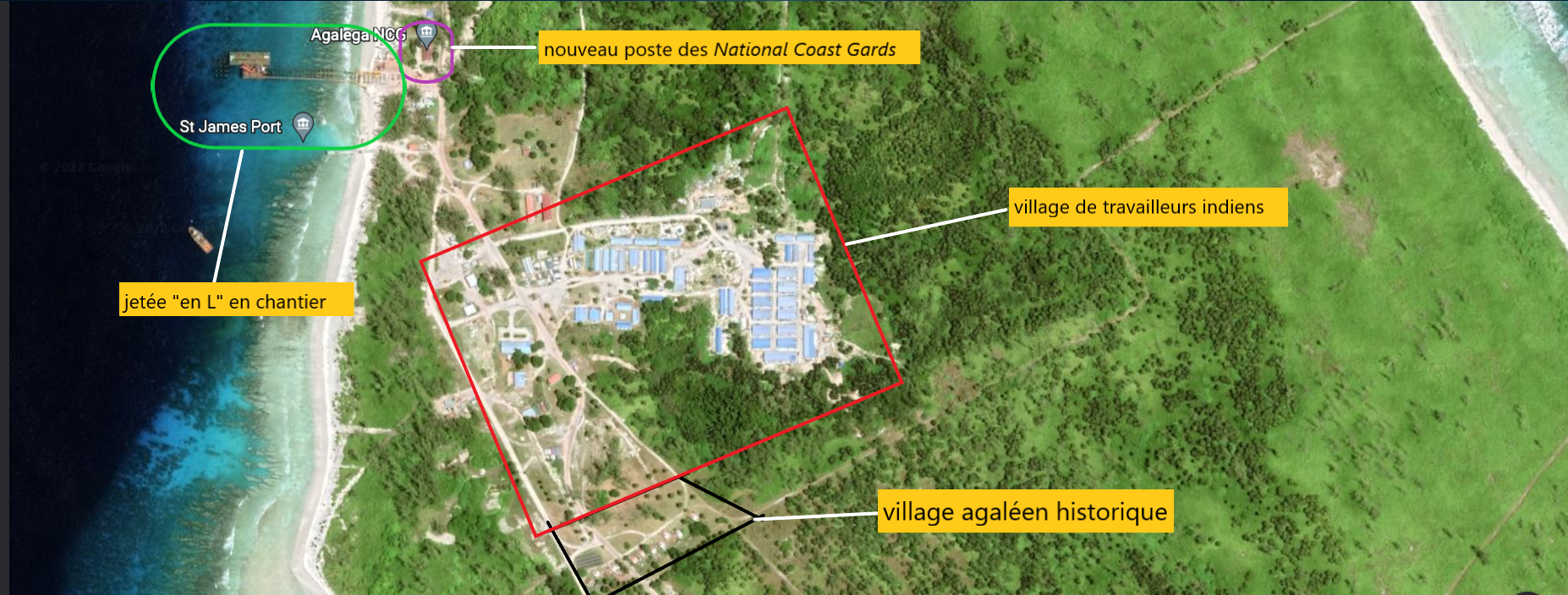
The buildings are presented as a genuine Indian army camp. There is every reason to believe that they are in fact housing for the hundreds of Indian workers dispatched to the site. Although the opposition media relayed rumours that the work was not being carried out by Afcons site managers but by Indian officers[35], we can speculate that if the government had been more pro-active in its communication and had defined a solid communication strategy with its Indian partner in advance, the response would not have been so confused. What’s more, a counter-narrative, albeit temporary, could have been built up, and would have ensured them a larger support base than the 8% or so of Mauritians currently opposed to the government being forced to account[36].
And yet... the situation in 2022
In order to check the effectiveness of the narrative initiated by AJ on the continuation of operations, and incidentally the veracity of AJ’s predictions on facilities such as the airfield “parking lot” or the “L-shaped jetty”, the problems listed in the introduction to this section could not be totally overcome. However, the information gathered, even if minimal compared to what other OSINT analysts have been able to do for more connected locations[37] [38], has allowed us to establish an implacable fact: the informational domination of the “anti-base” camp has changed nothing in the meteoric progress of the project.
"Arun" or the power of cross-checking
Because of the weather, satellite imagery was unable to show whether the L-shaped structure had been made operational in two years. The first step was to find out, because a negative answer would have shown that the information war waged by the proponents of the dominant narrative had been effective, and that the project had been brought to a halt.
Secondly, we also needed to know whether we were talking about a real port (a structure that stops the current and allows ships of all sizes to remain parked for long periods, and undergo repairs) or a simple pier, given that the first hypothesis would validate the repeated comparisons made by the proponents of the dominant narrative with the enormous American-British base at Diego Garcia.
Obtaining ground images was going to be difficult, until the “snap map” lit up around Agaléga. The Snapmap is a tool on the Snapchat social network that geotags photos and videos posted publicly by users around the world. Tapping your finger on a region, country or city provides instant access to a larger or smaller stream of image data in which locals depict their daily lives.
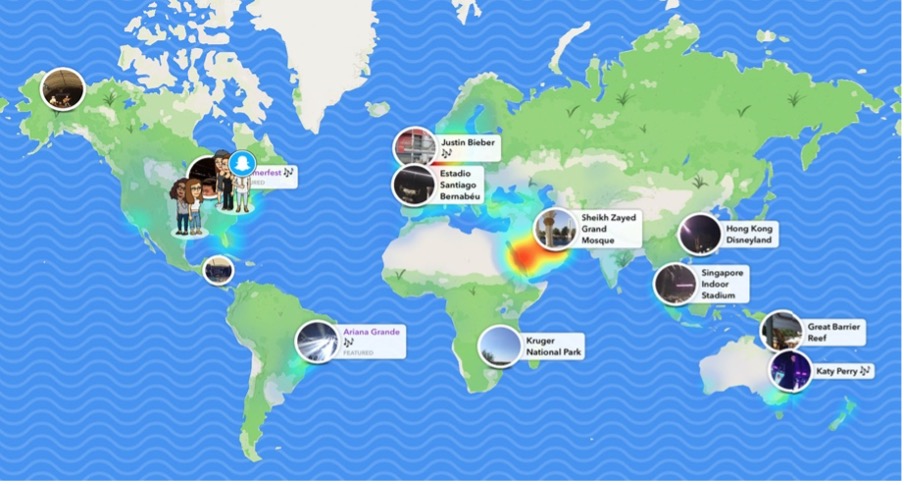
(© Snapchat)


Meet “Arun”[39], an Indian contract worker on Agalega-North. He posts daily on Snapchat his lunches, his outfits, his sports sessions… and, sometimes, things his employers probably wouldn’t want him to show. While trying to film a lizard climbing the wall of his office, he briefly revealed a folder entitled “U/S Items”. Arun unwittingly became the missing piece of the puzzle. One evening, wanting to film a sunset from the beach of the “Indian village”, he captured a split-second image of the “L-shaped structure” on the ground before zooming in on the sun.
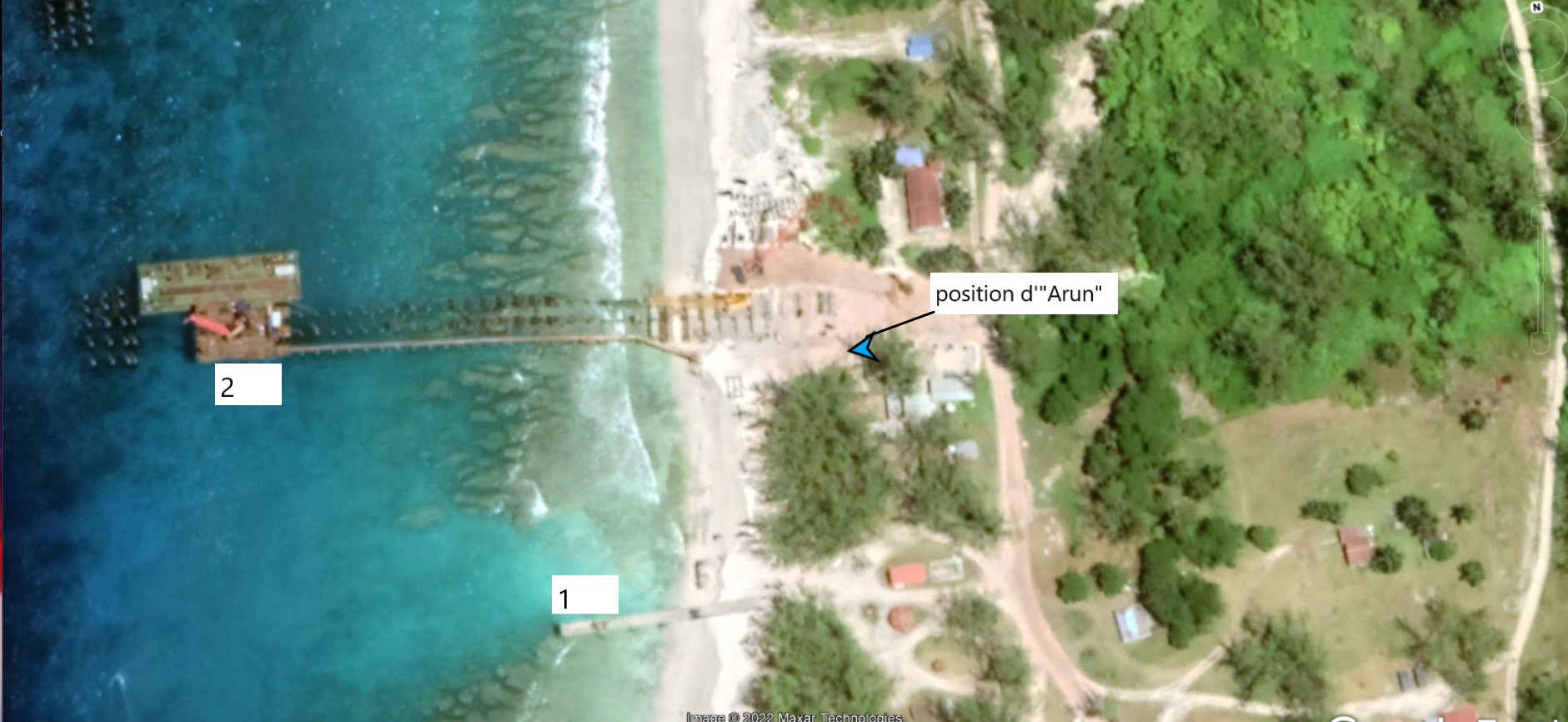
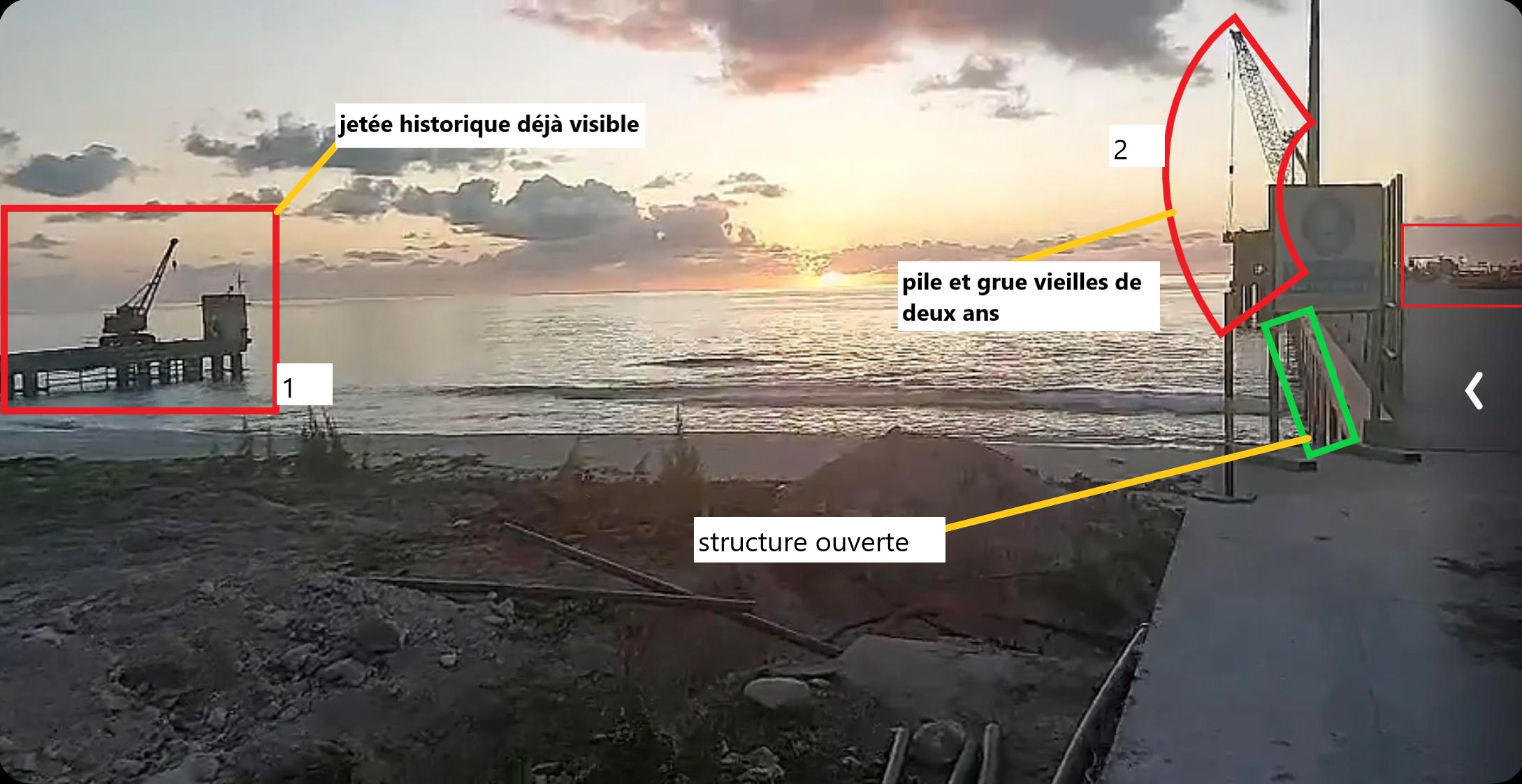
The structure’s piers can be seen under construction on the satellite images available from 2020 (2). The presence of the “historic” National Coast Guards jetty (1) allows us to pinpoint the approximate position of “Arun” and confirms that we’re dealing with the same installation. It can be clearly seen that the structure rests on stilts, and therefore does not stop the current, but merely increases the base’s capacity.
[34] L., Patrick « analyse OSINT-GEOINT : le cas de la prison d’Al-Sinna en Syrie », Association Werra (hors-série du 05/10/2022)
[35] KARGHOO, Christophe « Base militaire à Agaléga : entre doute, crainte et frayeur » 5 plus Dimanche [online] [accessed 11/27/2022]
[36] KARGHOO, Christophe « Base militaire à Agaléga : entre doute, crainte et frayeur » 5 plus Dimanche [online] [accessed 11/27/2022]
[37] B, ALEXANDRE « l’étrange manège d’un chasseur birman en Thaïlande » Projet Fox [online] posted online on 07/25/2022 [accessed on 12/04/2022]
[38] Projet Fox, « [Analyse OSINT] attaque sur la gare de Kramatorsk » Projet Fox [online] put online on 04/11/2022 [consulted on 12/04/2022]
[39] The subject’s true identity is unknown.
Conclusion: vain efforts?
“Arun” answers our main question in the following terms: the project has not been stopped or really slowed down by the seething debates which, however, are gaining in intensity on the mother island[40].
The Mauritian government, although completely overwhelmed by the state of the debate, is not flinching, or at least does not have the capacity to stop its Indian partner. New structures, difficult to identify despite cross-checking, are emerging from the sand and fulfilling Al Jazeera’s prophecy.
The base is still a vast construction site, and it will be several years before it is fully operational. Nevertheless, India has proved the ineffectiveness of informational warfare in the region by establishing a new military presence in the area, despite a blatant informational defeat and the implacable evidence provided by this heterogeneous coalition of local media, Qatari propagandists and Australian academics.
Clearly, the informational defeat that is the Agaléga crisis, if it can become a political defeat for the Mauritian government, is a victory for India, at all levels. Indeed, now considered as a serious regional interlocutor by France[41], India will be associated with the discussions which will take place between Mauritius and London on the sovereignty of Chagos[42].
This decision, which raised more than one eyebrow, confirms Mauritius’ vassal state status vis-à-vis India and P. Jugnauth’s strategy of involving New Delhi at all levels of its foreign policy. .
New Delhi, which does not see the danger, undoubtedly because the scandal fizzled out in India, would nevertheless have an interest in protecting Jugnauth and his ministers. The future could see the “pro-Indian” camp swept away and a more sovereignist government take up residence at Clarisse House, which would then rather have an interest in playing Realpolitik strategies to put India and China, which shows great competition, into competition. signs of interest in the paradise island[43]. With the “de-marginalization” of Mauritius, information warfare could then take on its full relevance.
[40] Interview of a Mauritian journalist with the author, December 2022
[41] GUPTA, Shishir “India and France to conduct joint surveillance of South West Indian Ocean” Hindustan Times [online] (accessed 09/12/2023)
[42] FLOCH, Fabrice “Maurice : la Grande-Bretagne va ouvrir les discussions pour la restitution des Chagos” Réunion la 1e [online] (accessed 09/12/2023)
[43] ANONYME “Axe Chine-Maurice : une centaine de compagnies chinoises sur le terrain de Jin Fei d’ici 2024” Le Mauricien [online] (accessed 09/12/2023)
Epilogue: the construction site in 2023
10 months after the first version of this article was written, satellite imagery shows us a naval air complex that looks ready to go into operation. Notable changes include the dismantling of the “zigzag jetty” and the completion of the “L jetty”. Small freighters are now parked here. The facilities in the Indian village are more numerous and larger. The area to the north of “The Forks” seems to have been reorganized and could accommodate new infrastructures. However, there is nothing in the layout of the buildings to indicate with any certainty the military character of the facilities.
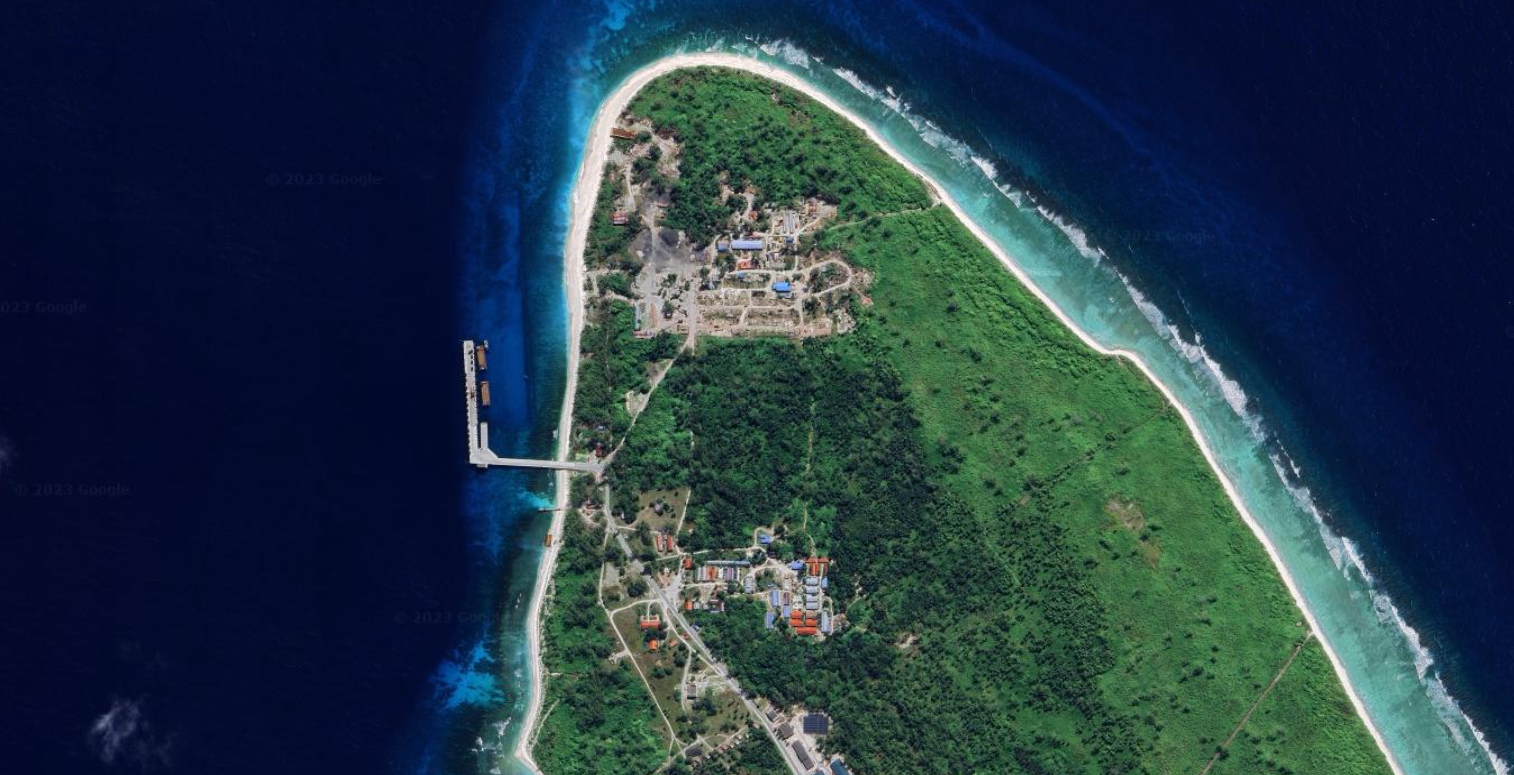
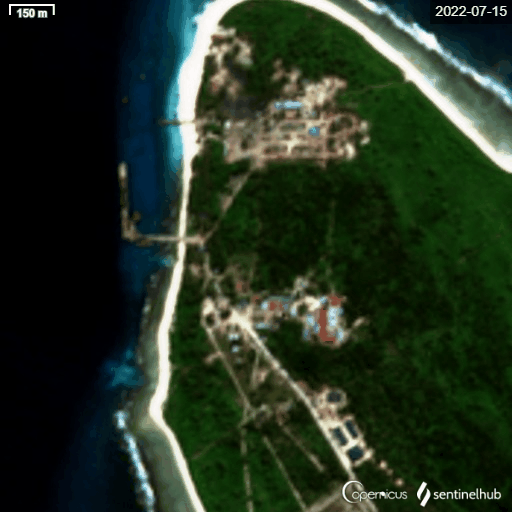
To the south, the evolution is less marked. The “parking lot” is now equipped with two buildings to serve as terminals. The runway is well-maintained and well-connected to the northern port area. New hangar-like facilities have sprung up between the two areas.
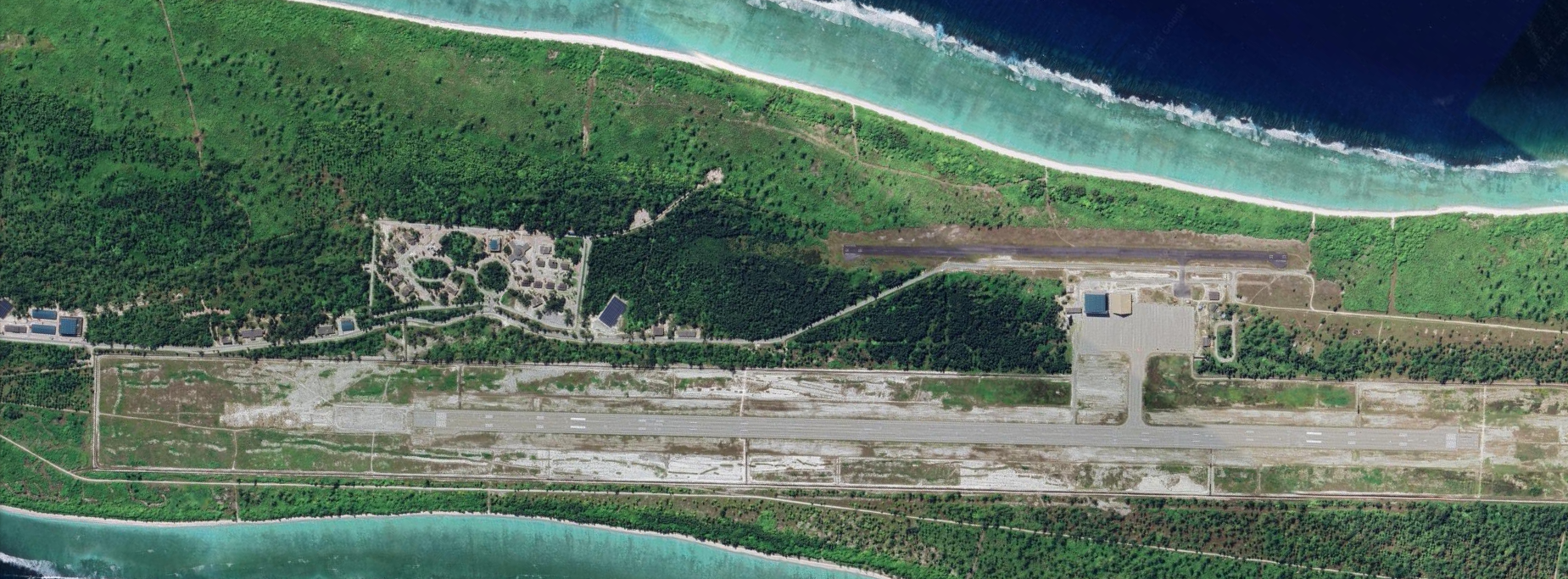
In Mauritius, the future of Agalega-North has become yet another political divide. The opposition continues to denounce the silence of the Jugnauth government[44], whose leader went to the G20 and certainly discussed the upcoming commissioning of the base with his Indian counterpart, although the presence of Indian military personnel on the islet has not yet been confirmed. Analysts in India openly welcomed the new Indian presence in the Indian Ocean, describing the new buildings as “barracks and [training] fields”[45]. Ten months later, the conclusions of this article are confirmed: despite a crushing informational defeat, in a few weeks’ time India will have a brand-new naval air complex in one of the most critical zones for its rise to power.
[44] MINAS, Bruno « MAURICE : une base militaire indienne, cachée aux mauriciens » Réunion la 1e [online] posted online on 09/12/2023 (accessed 09/14/2023)
[45] ADMIN « Overseas Indian Military Base At Agalega Islands In Mauritius Nears Completion” Indian Defense Research Wing [online] posted on 09/5/2023 (accessed 09/14/2023)